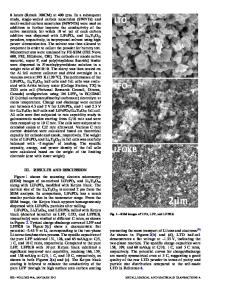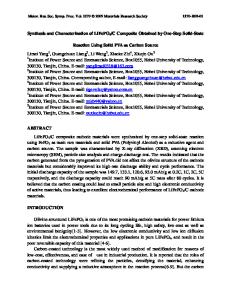Overcharge Self-Regulated Li-ion Battery Based on LiFePO 4 via a Solid State Combined Cathode
- PDF / 277,814 Bytes
- 6 Pages / 432 x 648 pts Page_size
- 20 Downloads / 411 Views
Overcharge Self-Regulated Li-ion Battery Based on LiFePO4 via a Solid State Combined Cathode Fei Gu1,2,4, Kichang Jung3,4, Taehoon Lim1,2,4, Alfredo A. Martinez-Morales1,2,4 1 Materials Science and Engineering Program, University of California, Riverside, California 92521 2 Winston Chung Global Energy Center, University of California, Riverside, California 92521 3 Department of Chemical and Environmental Engineering, University of California, Riverside, California 92521 4 College of Engineering Center for Environmental Research and Technology University of California, Riverside, California 92507
ABSTRACT Safety is one of the most crucial problems faced by the lithium-ion battery (LIBs) industry. In this work, we propose a strategy to avoid overcharging of a battery via the application of a solidstate combined cathode. The goal of this research is to produce LIBs with overcharge selfregulation capabilities. In order to achieve self-regulation functionality, 1,4-di-tert-butyl-2,5dimethoxybenzene (DBB) is added to as-synthesized LiFePO4, post synthesis. DBB has a trigger voltage of 3.9 V. When this voltage is reached, DBB forms a reduced ion that is released into the electrolyte from the cathode side. The DBB ion transfers to the anode side where it oxidizes and transfers back to the cathode side. This process forms a redox shuttle and consumes the extra charges keeping the voltage at a safe level (i.e. 3.9 V). The DBB redox shuttle protects the LiFePO4-based LIBs with working voltage between 3.4 and 3.5 V. The cycleability of assembled batteries is tested using an Arbin Tester.
INTRODUCTION Rechargeable lithium-ion batteries (LIBs) are a common power source for many portable electronic devices. Long battery lifetime, high specific capacity, and their compatibility with modern electronics have contributed to their widespread use [1]. Safety is a significant contemporary issue in LIBs research because abuse to the batteries can potentially cause serious safety issues. In general, there are three types of abuse: 1) mechanical (e.g. crushing, dropping); 2) electrical (e.g. overcharging, overdischarging, and high current surge); and, 3) thermal (excessive heat exposure). These forms of abuse lead to exothermic reactions that may cause thermal decomposition of the electrolyte, reduction of the electrolyte by the anode, oxidation of the electrolyte by the cathode, and even thermal decomposition of the anode and cathode. Sometimes the melting of the separator can also be triggered. All of these situations can lead to critical battery failure and even to a dangerous event such as fire [2]. This research addresses electrical abuse, which can include overcharging, overdischarging, and high power surge. Among these, safety hazards caused by overcharging are most frequently reported in the literature. This is mainly because the positive electrode in a fully charged Li-ion cell contains a strong oxidizing transition metal oxide such as Ni, Co, or Mn. The negative
445 Downloaded from https:/www.cambridge.org/core. University of P
Data Loading...











